UV-3600i Plus - Applications
UV-VIS-NIR Spectrophotometer
Electrical, Electronics, and Optics
Transmittance Measurement of Lenses
Multilayer dielectric films are used to coat lenses, mirrors, filters, and various other optical elements used in cameras, binoculars, and other optical devices. The figures below show results from measuring a multilayer dielectric film band-pass filter as the incident light angle is varied. By using the UV-3600i Plus in combination with an optional MPC-603A multipurpose large sample compartment and variable angle measurement attachment, transmittance and absolute reflectance can be measured as the angle of incidence is varied for various light. The results confirm that, because of the multilayer film structure, varying the incident angle changes which wavelengths are transmitted and reflected. Shimadzu’s unique aperture design provides condensed light with an excellent signal-to-noise ratio, which means it can be converted easily to highly collimated light to accommodate customer measurement requirements.

Transmittance Measurement of Very Small Samples
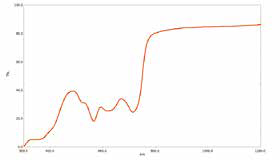
The current miniaturization of various products, such as sensors, means that the measurement of very small samples is now required. The gure shows the results of a transmission spectrum measurement on a micro-sensor window. When measuring very small samples, the light beam must be adjusted to the sample size. Therefore, by using the UV-3600i Plus in combination with an optional MPC-603A multipurpose large sample compartment, small beam aperture unit (P/N 206-22051-41), and small sample holder (P/N 206-28055-41), the optical system can be configured to enable measurement of even micro areas by focusing the beam down to diameters as small as 2 mmø. The MPC-603 is a UV-3600i Plus option that enables the measurement of various samples ranging from small large. The MPC-603 is a UV-3600 Plus option that enables the measurement of various samples ranging from small large.

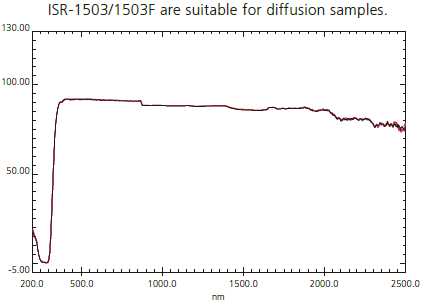
Transmittance Measurement of Rolled Plate Glass for Solar Cell
Rolled plate glass is a plate glass with rough surface. When it is scanned by Small ID Integrating sphere, large steps at detector switching wave length may be occurred, and correct results may not be obtained. When It run by ISR 1503 with ID 150 mmø, and the sample was turned with 0, 45 and 90 degree, obtained spectra were almost same. And those spectra had very small steps at detector switching wave length.
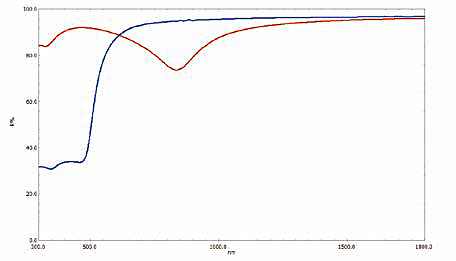
Absolute Reflectance Measurement of Mirrors
The reflectance of mirrors used in telescopes, lasers, and some other devices is extremely important because it serves as a factor in determining their performance. The total light reflecting off of a sample can be composed of a specular component and a diffuse component. For mirrors, the specular reflectance is the reflectance component of significance. In addition, reflectance measurements can be made as relative to the reflectance of a background material or as absolute. Absolute values of specular reflectance are determined by use of an absolute reflectance measurement (ASR) accessory. The figure below shows the results of measuring a mirror. An absolute reflectance attachment, which enables measuring the reflectance of mirrors, can be installed on the optional MPC-603 unit.
Evaluating Multilayer Dielectric Films
Multilayer dielectric films are used to coat lenses, mirrors, filters, and various other optical elements used in cameras, binoculars, and other optical devices. The figures below show results from measuring a multilayer dielectric film band-pass filter as the incident light angle is varied. By using the UV-3600i Plus in combination with an optional MPC-603A multipurpose large sample compartment and variable angle measurement attachment, transmittance and absolute reflectance can be measured as the angle of incidence is varied for various light. The results confirm that, because of the multilayer film structure, varying the incident angle changes which wavelengths are transmitted and reflected. Shimadzu’s unique aperture design provides condensed light with an excellent signal-to-noise ratio, which means it can be converted easily to highly collimated light to accommodate customer measurement requirements.
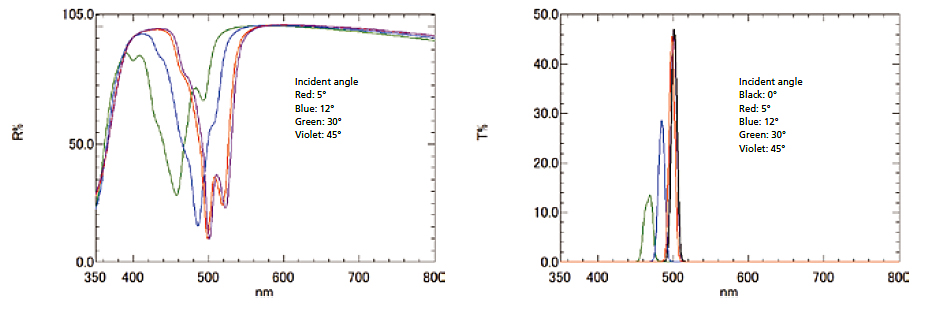
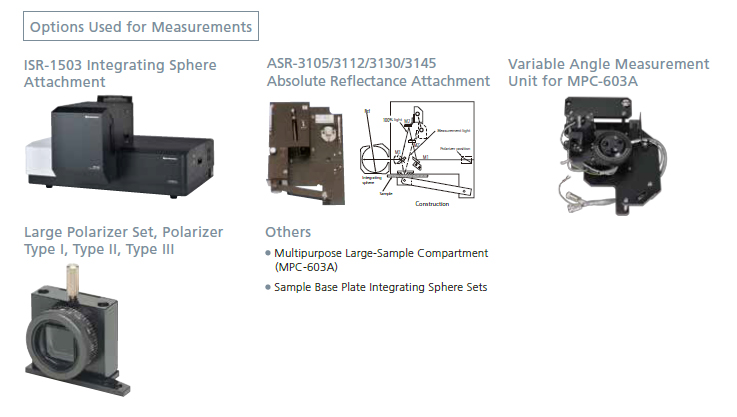
Band Gap Calculation
Research into solar-cell and photocatalytic materials often involves the measurement of the band gap*, which is a basic physical property of the materials. Shown below are the diffuse reflectance spectra of three semiconductor materials used in the production of solar cells using the ISR-603 integrating sphere. The absorption edge, the wavelength where the reflectance decreases, differs depending upon the sample type. This difference indicates a difference in the band gap of the samples. The band gaps of the samples were calculated using the Tauc method, and were determined to be 1.63ev for CuGaSe2 (red line) 1.27 eV for Culn0.5Ga0.5Se2 (blue line) and 0.99 eV for CuInSe2 (black line).
* The band gap refers to the energy difference between the top of the valence band filled with electrons and the bottom of the conduction band devoid of electrons. The wavelength range of the UV-3600i Plus is extremely effective for band gap calculations.

Construction
Measuring the Transmittance (Solar Transmittance) of Window Glass
In recent years, measures to offset the effects of Global Warming and Heat Islands have included the incorporation of various kinds of functional glass into modern building materials. These new glass materials reduce the transmittance of infrared radiation and also offer thermal insulation potential. Solar transmittance is defined by JIS as an index that represents the transmission characteristics of sunlight, from visible to near-infrared light. The figure below shows spectral data of transparent glass and suncut glass, and solar transmissivity/reflectance calculation results. It reveals that solar transmittance varies depending on the type of glass. This method of measuring solar transmittance requires a 250 to 2100 nm measurement range and an integrating sphere. The combination of the UV-3600i Plus and ISR-603 is ideal for solar transmittance measurements.
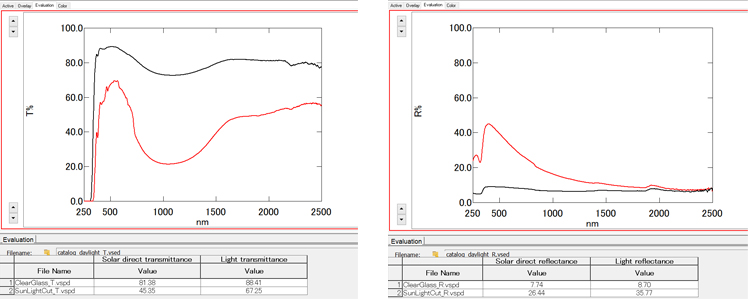
Transportation Equipment
LiDAR Collision Avoidance Sensor Evaluation System
LiDAR is a technology essential for self-driving vehicles. It measures the distance to and position of obstructions by scanning with laser light to measure the light reflected from obstructions. The results below were measured from the protective cover of a collision avoidance sensor as the incident light angle was varied. Considering that the transmittance level changes as the incident angle is varied, the results indicate that the laser wavelength used for the sensor should be near 960 nm, where transmittance does not decrease for the given cover material.

Chemicals
Haze measurement of Plastics
Because plastics are widely used now, clear plastic materials are required such as lens. Haze value is a one kind of evaluation of transmittance for plastics. Haze value is calculated by ratio of total transmittance and defuse reflectance. Smaller Haze value is more clear material. ø150mm ISR-1503 can mount transmittance sample as horizontal. Here is a Haze measurement result of misty plastic plate. Spectra were ones of total transmittance and defuse reflectance. Haze value was 32.9.

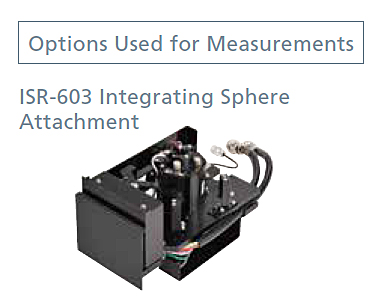
Solar radiation calculation
This software calculates solar transmittance/reflectancefrom measured spectra.
- The main calculation items are visible light transmittance/reflectance, total light transmittance/reflectance, near infrared reflectance, ultraviolet transmittance, CIE damage factor, and skin damage factor.
- The related items of JIS, ISO and GB/T can be calculated.
- For various calculations, you can set the measurement illuminant and observation viewing angle.
Software to calculate UPF (ultraviolet shielding factor) from measured spectrum.
- MPC-603 Multi-Purpose Large-Sample Compartment.
- Variable Angle Measurement Unit for MPC-603A
- Excel macro program for band gap
- Color calculation
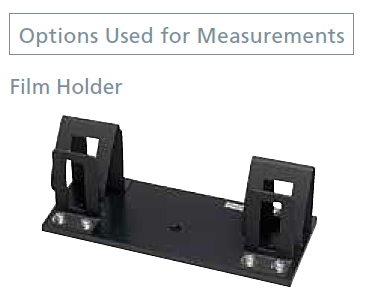
Film thickness measurement of the film
Interference wave patterns sometimes occur when light passes through a transparent film. The film thickness of a sample can be determined by using the interference waveform. The black line is for polyvinylidene chloride film, the red line is for polycarbonate film, and the blue line is for polypropylene film. The values of 9.9 μm, 49.3μm, and 59.5 μm were calculated from the interference waveforms using the optional film thickness calculation.
Note: The refractive index of the sample must be entered in order to perform the calculation.
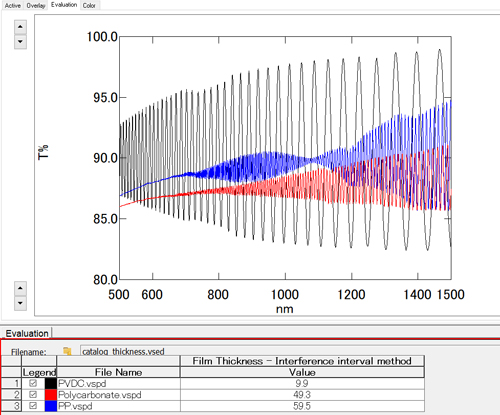
Film thickness calculation
This software calculates the film thickness from the measured spectrum using the interference interval method. (An input of the refractive index of the sample is required to calculate the film thickness.)
・ The Interference method calculates the film thickness from the distance between the peaks of the interference waveform (Baray). You can set the detection parameters for the peak (Baray) and the incident angle and wavelength range for the film thickness calculation.
Pharmaceuticals
Measurement of Anhydrous Caffeine in Cold Remedy
Anhydrous caffeine is included in cold medicines. The figure below shows the results of measuring anhydrous caffeine using a powdered sample holder. It enables volumes as small as 0.16 mL to be measured easily.
The combination of the UV-3600i Plus, ISR-603, and powdered sample holder is ideal for the diffuse reflectance measurement of powder.

Foods
Quantitation of Amount of Fat in Foods
Recently, fat-modified products become widely available. Gerber method and Roese-Gottlieb method are usually used to determine the fat level in milk, while it requires a long measurement time. Therefore, the measurement was conducted using a combination of spectral reflectance method and multivariate analysis. The figure below shows the spectral reflectance spectrum of milk sample, which was placed in a screw tube, measured by UV-3600i Plus and ISR-603. The quantitation of amount of fat was conducted by generating a calibration curve using the spectrum and fat amount data.

Textiles
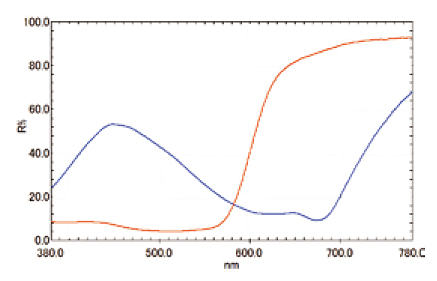
Diffuse Reflectance Measurement of Various Fabrics
The diffuse reflectance spectra of various textiles were measured in the visible region using the ISR-603 integrating sphere attachment. The blue line indicates a blue fabric and the red line indicates a red fabric. The blue fabric mainly reflects short-wavelength blue light, so it appears blue, while the red fabric mainly reflects long-wavelength red light, so it appears red. The combination of the UV-3600i Plus and the ISR-603 is ideal for measuring color. Also, the optional color measurement software enables colors to be calculated and displayed in a variety of color space models.
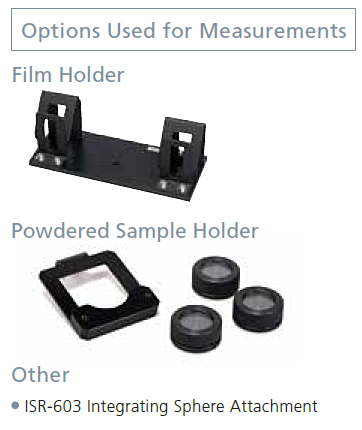
Other
- ISR-603 Integrating Sphere Attachment
Color calculation
Software that calculates the color value of a measurement from the measured spectrum. You can display a graph of the chromaticity coordinates xy in the XYZ colorimetric system or a graph of the luminosity index/color coordinates in CIELAB.
- Contains the main calculation items for the XYZ colorimetric system, CIELAB, CIELUV, Munsell colorimetric system, mentality, yellowness, whiteness, and color difference.
- You can calculate items related to JIS and ASTM colors. *
- For various calculations, you can set the measurement illuminant and observation viewing angle.
Software to calculate UPF (ultraviolet shielding factor) from measured spectrum.
- UPF, UVA, UVB, UV block rate, UV block rate (UVA, UVB) can be calculated.
- You can calculate related items of JIS, DIN, BS, AATCC, AS/NZAA, GB/T. *
- You can calculate related items of JIS, DIN, BS, AATCC, AS/NZAA, GB/T. *
* Please contact us for details on the corresponding standard.



